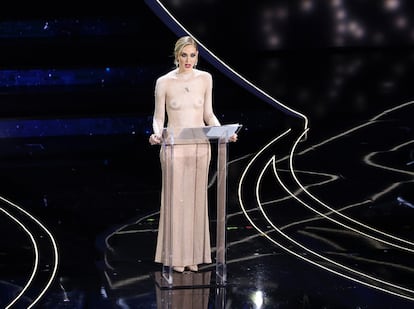Chiara Ferragni takes aim at the patriarchy with The Shameless Dress
At the Sanremo Music Festival in Italy, the Italian social media influencer wore four different gowns, each with a strong message about breaking gender stereoptyles

Italian social media influencer Chiara Ferragni has taken a stand against the patriarchy at the Sanremo Music Festival in Italy. As co-host, the 35-year-old wore four different dresses, each with a strong message about breaking gender stereotypes and women’s’ rights. The looks – designed by Dior’s creative director Grazia Chiuri – were called: The Shameless Dress, The Hate Dress, The Cage and The Manifesto Dress.
Photos of the dresses, shared by Ferragni on Instagram, have received more than five million likes and hundreds of thousands of comments.
The Instagram posts also include a written statement explaining the idea behind each of the designs. This is what they said:
The Shameless Dress
“The objective behind this look is to shed light on the rights that concern women and their bodies. And on how the disposal of the female body by the very same women is, unfortunately still discussed and even considered questionable. [...] The nude color dress, which was realized in Dior’s haute couture atelier, uses a trompe l’oiel embroidery to reproduce Chiara Ferragni’s body freed from the shame that has always been imposed on women, starting with Eve, the first woman in history persuaded to feel shame.
“The illusion of nudity aims to remind women of the right they have to show and handle themselves without feeling judged or guilty. [...] This is the body of a woman, the body of Chiara Ferragni, would like to give voice to all the women who are told that their body is shameful and that it’s nothing more than an object of desire that incites sin. This is the body of all women. Let him who is without sin cast the first stone!”
The Hate Dress
“With this peplos dress, we bring on the stage of the Ariston theater some of the criticisms addressed at Chiara regarding her appearance, her body and, above all, her freedom of feeling a woman other than a mother. The sentences of disdain embroided with black pearls are the true insults that every day haters direct at the photos she posts on Instagram. Maria Grazia Chiuri had the idea of embroidering these words black on a white peplos as if the dress was the page of a book that narrates the fruitless disdain against which we need to fight every single day.”
The Manifesto Dress
“When we started to think about the dresses for the two evenings of San Remo, we immediately realized that we didn’t want gowns that were simply eccentric or pretentiously beautiful. We felt the need to bring on to the most popular stage of Italy a social message, even through fashion. The manifesto dress that kick starts the 73rd edition of the Fesitval di Sanremo is the product of a conversation between Maria Grazia, creative director of Dior, Rachele Regini and Fulvia Carnevale, of the artistic duo Claire Fontaine. The result is a black silk corolla dress inspired by Dior’s tradition that is integrated with the manifesto-stole embroided with the claim ‘Pensati libera,’ which translates to ‘Think yourself free.’ The simple yet so strong words come from the work of Claire Fontaine and we hope they can inspire all women to feel free to break out of the role that was imposed on them by society. The words represent a realization of Chiara Ferragni, who fights to not be boxed into a space defined for her by the patriachy, and a promise that she makes to herself every day while she fights to not feel guilty for her success as a woman. ‘Pensati libera’ is dedicated to all the women who wish simply to be themselves without being judged.”
The Cage
“Freeing the new generations from the gender stereotypes in which women often feel caged is the idea that Maria Grazia Chiuri wanted to represent with this haute couture Dio dress, which consists of a jersey jumpsuit embroided with rhinestones, trapped in a tulle skirt that takes inspiration from the work of Jana Sterbak. This gown represents the hope to break the conventions imposed by the patriarchy. A hope that we place in today’s young girls who will be the women of tomorrow. This is the wish that a mom makes to her daughter: that she can finally shout out Vittoria!
Sign up for our weekly newsletter to get more English-language news coverage from EL PAÍS USA Edition
Tu suscripción se está usando en otro dispositivo
¿Quieres añadir otro usuario a tu suscripción?
Si continúas leyendo en este dispositivo, no se podrá leer en el otro.
FlechaTu suscripción se está usando en otro dispositivo y solo puedes acceder a EL PAÍS desde un dispositivo a la vez.
Si quieres compartir tu cuenta, cambia tu suscripción a la modalidad Premium, así podrás añadir otro usuario. Cada uno accederá con su propia cuenta de email, lo que os permitirá personalizar vuestra experiencia en EL PAÍS.
¿Tienes una suscripción de empresa? Accede aquí para contratar más cuentas.
En el caso de no saber quién está usando tu cuenta, te recomendamos cambiar tu contraseña aquí.
Si decides continuar compartiendo tu cuenta, este mensaje se mostrará en tu dispositivo y en el de la otra persona que está usando tu cuenta de forma indefinida, afectando a tu experiencia de lectura. Puedes consultar aquí los términos y condiciones de la suscripción digital.
More information
Archived In
Últimas noticias
There is as much life left to discover on planet Earth as that which is already known
Dozens presumed dead, around 100 injured in fire at Swiss Alps bar during New Year’s celebration
Is porn for women different from conventional porn? We spoke to those who make it
Cartagena de Indias is sinking: What can the city do to mitigate it?
Most viewed
- David King, chemist: ‘There are scientists studying how to cool the planet; nobody should stop these experiments from happening’
- Reinhard Genzel, Nobel laureate in physics: ‘One-minute videos will never give you the truth’
- Oona Chaplin: ‘I told James Cameron that I was living in a treehouse and starting a permaculture project with a friend’
- Sinaloa Cartel war is taking its toll on Los Chapitos
- The Interoceanic Train, the Mexican alternative to the Panama Canal










































